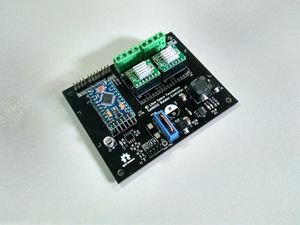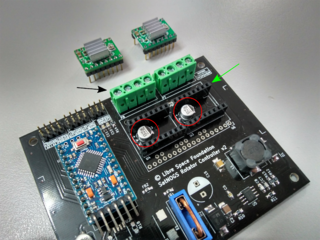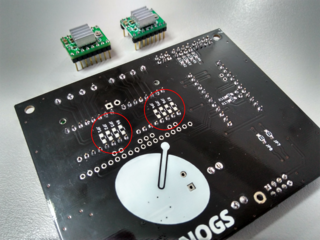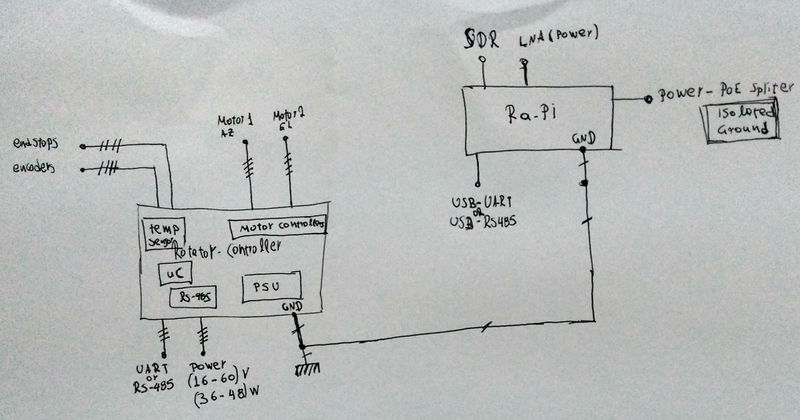Difference between revisions of "SatNOGS Rotator Controller"
(→Motor Drivers) |
(→Motor Drivers) |
||
| Line 41: | Line 41: | ||
==== Motor Drivers ==== | ==== Motor Drivers ==== | ||
| − | + | ===== ''Stepper motor driver'' ===== | |
| − | [[File:Stepper_2.png|thumb|320x240px]] | + | [[File:Stepper_2.png|thumb|320x240px|Stepper motor driver]] |
| − | [[File:Stepper_1.png|thumb|320x240px]] | + | [[File:Stepper_1.png|thumb|320x240px|Jumpers]] |
| + | |||
| + | For the stepper motor driver 2 options are tested, [https://www.pololu.com/product/2133 DRV8825] and [https://www.pololu.com/product/1182 A4988]. | ||
| + | For both options it is necessary to solder | ||
| + | * 2 electrolytic capacitors C3, C4 100uF (red circles, Stepper motor driver) | ||
| + | * 4 single 0.1" male connectors for U3, U4 (green arrow, Stepper motor driver) | ||
| + | * 2 fixed terminal blocks, Phoenix 1985467 (black arrow, Stepper motor driver) | ||
| + | * 6 jumpers to adjust the micro-step, '''default option is Full Step''' (red circles, Jumpers) | ||
| + | * '''Not''' solder 2 resistor 100k, R4, R7 (red circles, Jumpers) | ||
| + | |||
| + | It is important to [http://reprap.org/wiki/Pololu_stepper_driver_board adjust the current (current limiting) for stepper motors] and to add a heat-sink. | ||
| + | |||
{| {{table}} | {| {{table}} | ||
| align="center" style="background:#f0f0f0;"|'''JP3/JP6''' | | align="center" style="background:#f0f0f0;"|'''JP3/JP6''' | ||
| Line 50: | Line 61: | ||
| align="center" style="background:#f0f0f0;"|'''Microstep Resolution''' | | align="center" style="background:#f0f0f0;"|'''Microstep Resolution''' | ||
|- | |- | ||
| − | | align="center"|'''Low''' || align="center"|'''Low''' || align="center"|'''Low''' || align="center"|'''Full step''' | + | | align="center" style="background:#f0f000;"|'''Low''' || align="center" style="background:#f0f000;"|'''Low''' || align="center" style="background:#f0f000;"|'''Low''' || align="center" style="background:#f0f000;"|'''Full step''' |
|- | |- | ||
| − | | align="center"|''' | + | | align="center"|'''High''' || align="center"|'''Low''' || align="center"|'''Low''' || align="center"|'''Half step''' |
|- | |- | ||
| − | | align="center"|'''Low''' || align="center"|''' | + | | align="center"|'''Low''' || align="center"|'''High''' || align="center"|'''Low''' || align="center"|'''1/4 step''' |
|- | |- | ||
| − | | align="center"|''' | + | | align="center"|'''High''' || align="center"|'''High''' || align="center"|'''Low''' || align="center"|'''1/8 step''' |
|- | |- | ||
| − | | align="center"|'''Low''' || align="center"|'''Low''' || align="center"|''' | + | | align="center"|'''Low''' || align="center"|'''Low''' || align="center"|'''High''' || align="center"|'''1/16 step''' |
|- | |- | ||
| − | | align="center"|''' | + | | align="center"|'''High''' || align="center"|'''Low''' || align="center"|'''High''' || align="center"|'''1/32 step''' |
|- | |- | ||
| − | | align="center"|'''Low''' || align="center"|''' | + | | align="center"|'''Low''' || align="center"|'''High''' || align="center"|'''High''' || align="center"|'''1/32 step''' |
|- | |- | ||
| − | | align="center"|''' | + | | align="center"|'''High''' || align="center"|'''High''' || align="center"|'''High''' || align="center"|'''1/32 step''' |
|- | |- | ||
|} | |} | ||
| − | + | ===== ''DC motor driver'' ===== | |
==== Communication ==== | ==== Communication ==== | ||
Revision as of 13:41, 30 August 2017
| SatNOGS Rotator Controller | |
|---|---|
| Information | |
| Type: | Rotator Controller for SatNOGS rotator. |
| Cost: | |
| Release Information | |
| Status: | Working |
| Latest Release: | [ ] |
| Repository: | [] |
| Documentation: | [] |
Intro
SatNOGS Rotator Controller refers to the set of electronics designed to operate a SatNOGS Rotator. There have been multiple iterations of the rotator controller design, but the modularity of the approach enables operations between different versions of the controller and the rotator. Since the start of 2016, the rotator controller design is able to facilitate a DC-motors or stepper-motors rotator design. We intend to keep this modularity for the electronics and firmware design to facilitate the variety of build by our community.
Rotator Controller v2
The PCB are tested in this ground station.
Features
- It is designed to fit the entire electronics needed to control rotator in Euroboard 80x50 mm.
- Main micro-controller is Arduino pro-mini dev-board with ATmega328p.
- The modular design includes plug-in either stepper drivers (DRV8825) or DC motor drivers (MC33926).
- The power supply in embed in the same board in contrast with previous version.
- Filter in power supply of micro controller.
- It has an I2C multiplexer to connect I2C encoders AS5601 (same ID) to get position feedback for each axis.
- A temperature sensor TC-74 monitoring the temperature inside the controller box in order to protect them from over-temperature.
- More dev-pins to connect other peripherals like IMU, LCD display.
- Pins with RC-Low Pass filter for end-stops.
- Default communication interface is RS-485 (WIP) but it can be also used UART.
- Avoid connection with GNDD directly with motor GND use keep out area.
- Electrolytic capacitor and TVS-diode in PSU input
Build sequence
- Make sure you have a mechanical assembly of the rotator constructed and ready
- Buy the PCB
- Assemble the PCB, by soldering the components
- Burn the firmware
- Using the wiring diagram, connect the controller to the Rotator
- You are ready! Proceed with testing
Motor Drivers
Stepper motor driver
For the stepper motor driver 2 options are tested, DRV8825 and A4988. For both options it is necessary to solder
- 2 electrolytic capacitors C3, C4 100uF (red circles, Stepper motor driver)
- 4 single 0.1" male connectors for U3, U4 (green arrow, Stepper motor driver)
- 2 fixed terminal blocks, Phoenix 1985467 (black arrow, Stepper motor driver)
- 6 jumpers to adjust the micro-step, default option is Full Step (red circles, Jumpers)
- Not solder 2 resistor 100k, R4, R7 (red circles, Jumpers)
It is important to adjust the current (current limiting) for stepper motors and to add a heat-sink.
| JP3/JP6 | JP2/JP5 | JP1/JP4 | Microstep Resolution |
| Low | Low | Low | Full step |
| High | Low | Low | Half step |
| Low | High | Low | 1/4 step |
| High | High | Low | 1/8 step |
| Low | Low | High | 1/16 step |
| High | Low | High | 1/32 step |
| Low | High | High | 1/32 step |
| High | High | High | 1/32 step |
DC motor driver
Communication
- UART
- RS-485
Power Supply
Endstops
- Mechanical Endstops
Encoders
For stepper motor setup is optional.
- AS5601 encoder
Wiring
Rotator Controller enclosure - Placement
Firmware and Pin Assignments
Pre-Flight Check
Need to add testing procedure here.



